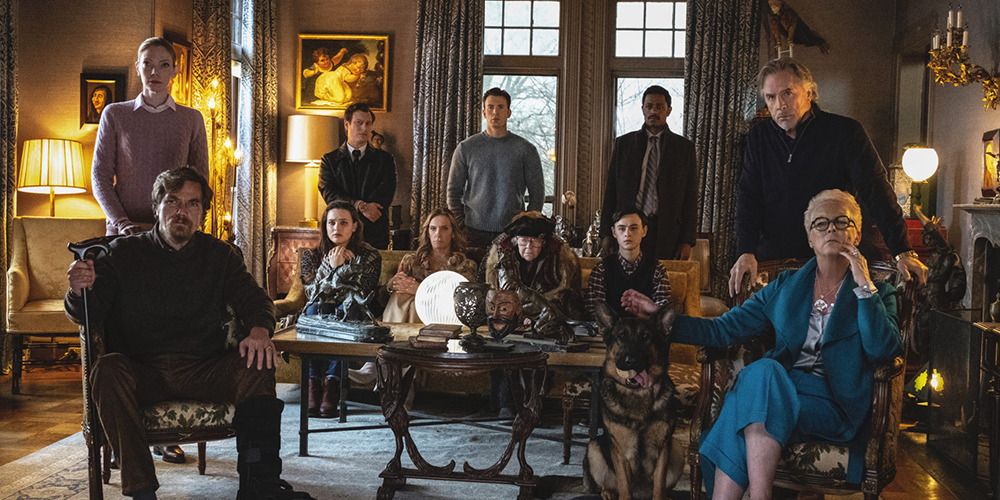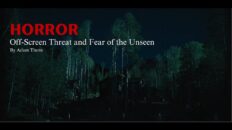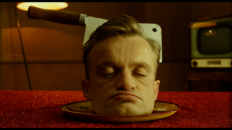Of course, movies (like any other money-making endeavor) chase popular trends, and murder mysteries have been popular for a long time. It was inevitable that Hollywood try its hand at the whodunit, but the results are generally disappointing. During the so-called Golden Age of Detective Fiction (roughly the 1920s and ‘30s), Tinsel Town spun out b- and c-grade quickies by the dozen: over fifty Charlie Chan movies, to mention one well-known property. The Charlie Chan films are generally poor endeavors; even were we to bracket the racial problematics of having a European actor playing a Chinese detective (accompanied, often, by Mantan Moreland for that extra fillip of racial insensitivity), the scripts for these Charlie Chan movies are often nonsense, the acting adequate at best, and the stale odor arising from them cannot be put simply down to the passage of time. Ellery Queen, Philo Vance, and Miss Marple fared little better. The history of the whodunnit in the cinema is a sad one.
There are bright spots, of course. In the late ’70s and into the ’80s, there were a series of Agatha Christie adaptations that ranged from excellent (Murder on the Orient Express, Evil under the Sun) to very good (The Mirror Crack’d) to terrible (Appointment with Death). These movies cracked the whodunnit code for cinema by realizing that plot isn’t what audiences really want. For all the laudatory talk about Agatha Christie’s plotting (and her talent at this is really quite stupendous), it’s the atmosphere that people like: that generally upper-middle-class (or higher) environment with just a hint of decadence, the seething undercurrent of snobbery, along with the understated pleasure of seeing a thoroughly unpleasant victim finally get what was coming to them.
What this translates to, practically, is comedy. I mean this both in the classical sense (in that everything ends well, often with a marriage) and in the more popular sense (in that people laugh out loud at it). Often, there’s a note of camp to it, as when the-decidedly-not elderly Angela Lansbury as Miss Marple puffs on a cigarette while wondering who could have murdered Marina Rudd (Elizabeth Taylor!) in The Mirror Crack’d or when Diana Rigg and Maggie Smith engage in verbal catfights in Evil under the Sun. The plot may be more or less intact from the Christie novel, but no one—in either the cast or the audience—pretends that they really care who killed Marina Rudd or Arlena Marshall or Linnet Ridgeway (in Death on the Nile). The cinematic whodunit is about mood, not plot.
Perhaps the most highly-evolved version of this is, of course, Clue, a movie which openly parodies genre conventions. Clue was famously shipped out with different endings to different markets, each ending identifying a different killer. The DVD version presents viewers with the option of watching all the endings together, but this is not how it was experienced by the audience originally. Each ending is “fair,” as far as it goes (“fairness” was always a delicately-maintained illusion in detective fiction), but they are all—including the true ending—preposterous.
Since the Christie adaptations of the 70s and 80s, the whodunnit has flourished most on television (for reasons I don’t have time to get into). Chances are that television will continue to be the primary venue for visual representations of the form, as long as there’s an audience for it. In the cinema, the genre has languished. Gosford Park was a remarkable endeavor, but it did not spark a revival of big screen whodunits; its most lasting legacy may be Downton Abby (another topic for another day and another writer). More recently, Kenneth Branagh had some success with his remake of Murder on the Orient Express (1) (2). This endeavor sparked a forthcoming sequel, but there seems little chance of other properties following suit. Whodunits remain rare miracles in the cinematic world.
Enter Knives Out. In retrospect, it seems natural that Rian Johnson, himself a kind of cinematic necromancer, would attempt to conjure the whodunit again. Johnson has already dipped his fingers into noir with his extremely good debut Brick (nothing in his subsequent oeuvre has touched this film’s mixture of the radical and traditional) and has dabbled in the caper (The Brothers Bloom), the science-fiction thriller (Looper), and the big-budget adventure (Star Wars: The Last Jedi)—in addition to a handful of well-regarded episodes of television. Each of his big-screen endeavors combine an obsessive love of genre with a desire to twist, subvert, or otherwise play with the genre’s conventions. Inventiveness is the watchword.
Of course, inventiveness is precisely what the whodunnit needs. Formally, the genre is among the strictest of popular genres: there is the murder, the interviews of suspects and following-up of leads, and the climactic reveal. Much ink has been spilled over the satisfactions of this kind of closed form, and I will not repeat the arguments here. However, simply hewing to the formal conventions does not a good whodunit make. The best writers invariably mix things up.
Few people are better suited to this sort of inventiveness than Johnson, whose cinematic career is one of respectful revisionism. In addition to the comic approach, Johnson adds his own twist: the insertion of the Hitchcockian thriller into the body of the whodunit. In an LA Times piece, Johnson talks about the rationale for this move, as well as the precedents he follows within the genre itself (Columbo, several Agatha Christie novels). Functionally, this means that—after the initial setup, interviewing suspects, and so on—Johnson devotes an extended flashback to telling viewers what really happened that night–or most of it, at any rate. The revelation provides for suspense; we now know something the detective does not know, and the process of watching him come close to (or draw back from) the truth gives the movie much of its drive.
The setup is pure Agatha Christie, though I will leave it to Christie experts to calculate how many of her stories take place in actual country houses; certainly only one of the big screen adaptations of the ’70s and ’80s is a country house mystery, and only one of those adaptations (Evil under the Sun) had its setting actually changed to make it more exotic. It is, anyway, the myth of Agatha Christie that she writes country-house mysteries, and it is the myth—not the reality—that determines generic play. Thus, Knives Out takes place in a country house, where the patriarch of a wealthy family has just been buried following his suicide (or was it).
What follows has a number of clever twists, though none so clever that the attentive viewer could not guess them well in advance (full confession: I did not guess them; my own solution was pretty traditional—but my viewing companion did). Plot is an excuse to get a famous actor to put on a funny accent and investigate things (in this case, it’s Daniel Craig in a broad “southern” accent. As an aficionado of bad southern accents, I approve). Plot is an excuse to get heavy-hitting actors to yell at each other, to have hysterics, and to generally have a gas. Plot is an excuse to wallow in the scenery and the setting and the pure almost-but-not-quite-camp of the thing.
One of the drawbacks of this comic/camp approach is that it makes it very difficult for these films to say anything serious, and if they try to say anything serious they run the risk of alienating fans. The final years of the Poirot television series were, in my recollection, criticized for going “too dark,” partly because they tried to deal with weightier themes—guilt, religion, and so on—that the comic/camp approach perfected by visual whodunits isn’t made to support. You can push up against the edge of heartbreak, as Rock Hudson does in his remarkable turn in The Mirror Crack’d, but you cannot go too far.
An argument can be made that Knives Out goes too far. Judging by this opinion piece in the New York Times, some viewers feel that the movie’s attempts to deal with serious issues such as race and structural white supremacy are insensitive and fall far short of their intended effect. I have no desire to contest the lived-and-reported experience of these individuals. The issue here is almost certainly one of genre; the contents of what the movie wishes to say are too much for the container. Perhaps Johnson could have chosen another container, and perhaps not. Nevertheless, this is the container we have.
It helps to consider the aim of the detective story. If we are to believe Auden, it is the return of order to a disordered world. I myself am a skeptic on that score and have written elsewhere about detectives as disrupters of order. Nevertheless, it is an easily grasped point: the detective must, by determining the truth, return the status quo to its proper order. What, though, if the entire status quo is rotten from the bottom to the top? Would it not be better to tear it down entirely? That is what this movie does, spectacularly, in its final scene. In this age of spoiler-phobia, it is impossible (alas!) to discuss this particular issue further; suffice it to say that the movie, if its methods are imperfect, at least has its heart in the right place. The final shot represents a social and psychic inversion that readers of the Bible will recognize as a fulfillment of a promise of the last coming first. It is a promise of revolution, and it’s here that Johnson most cleanly subverts the whodunit as it is traditionally conceived.
Will Knives Out bring the whodunit back to cinema screens? It is doubtful. Despite its success, the movie represents an outlier. More likely, the genre will continue in books (where cozy mysteries still sell very well, apparently, regardless of the vanishing midlist) and on television (the natural home of the televisual mystery). Death on the Nile comes out next year, and perhaps Branagh will continue the series. More than that is unlikely. And that’s fine. But Knives Out does represent what can be done when a creator who clearly loves the toys he is playing with is permitted to see what he can do with them. In this age of cookie-cutter superhero flicks, one can hope that, at least, that is a trend that does catch on.








